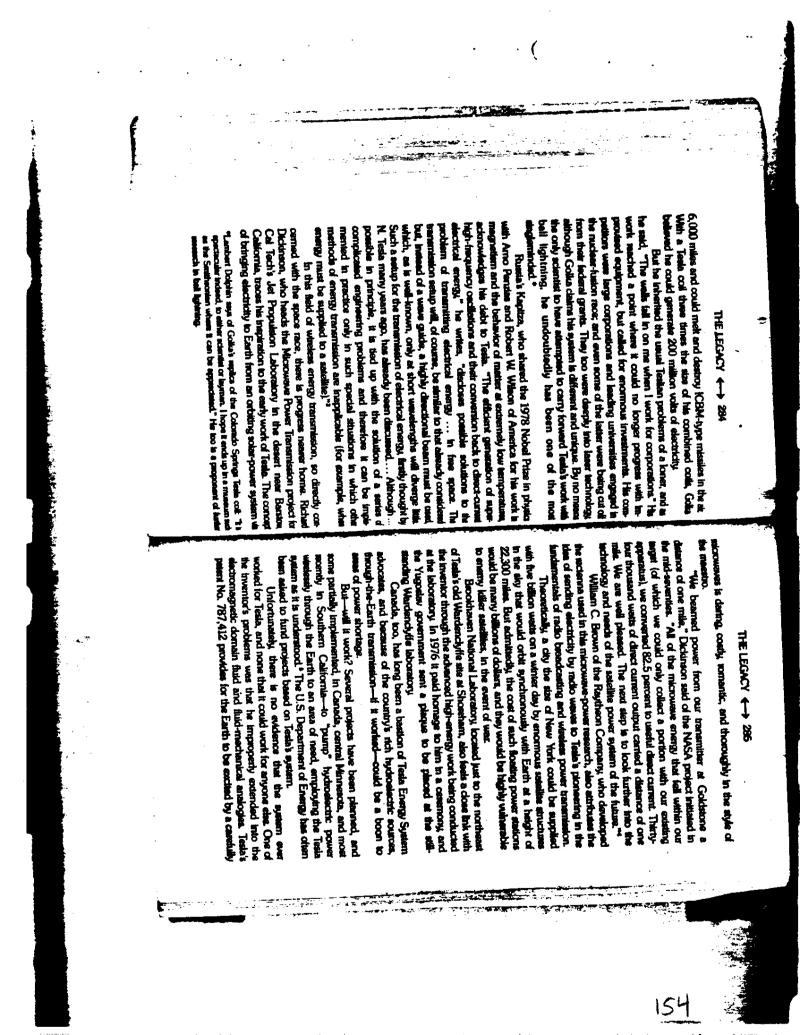
Nikola Tesla Documents
Nikola Tesla FBI Files - Page 154
THE LEGACY → 284 6,000 miles and could melt and destroy ICBM-type missiles in the at With a Tesla coll three times the size of his combined coils, Golla ballaved he could generate 200 million volts of electricity. But he inherited the usual Teslian problems of a loner, and as he said, "The walls fall in on me when I work for corporations." His work reached a point where it could no longer progress with improvised equipment, but called for enormous investments. His com | petitors were large corporations and leading universities engaged in the nuclear-fusion race; and even some of the latter were being cut off from their federal grants. They too were deeply into laser technology, although Golka claims his system is different and unique. By no meani the only scientist to have attempted to carry forward Tesla's work with ball lightning, he undoubtedly has been one of the most singleminded. Russia's Kapitza, who shared the 1978 Nobel Prize in physia with Amo Panzias and Robert W. Wilson of America for his work in magnetism and the behavior of matter at extremely low temperature, acknowledges his debt to Testa. "The efficient generation of super high-frequency oscillations and their conversion back to direct-curient electrical energy," he writes, "discloses possible solutions to the in free space. The problem of transmitting electrical energy ……. transmission setup will, of course, be similar to that already considemed but, Instead of a wave guide, a highly directional beam must be used, which, as is well-known, only at short wavelengths will diverge litt Such a setup for the transmission of electrical energy, firstly thought by N. Tesla many years ago, has already been discussed.... Although... possible in principle, it is tied up with the solution of a series of complicated engineering problems and therefore it can be imple menied in practice only in such special situations in which other methods of energy transmission are inapplicable (for example, when energy must be supplied to a satellite)" In this field of wireless energy transmission, so directly con cemed with the space race, there is progress nearer home. Richard Dickinson, who heads the Microwave Power Transmission project for Cal Tech's Jet Propulsion Laboratory in the desert near Barstow, California, traces his inspiration to the early work of Tesla. The concept of bringing electricity to Earth from an orbiting solar-power system via "Lambert Dolphin says of Golka's replica of the Colorado Springs Tesin colt spectacular indeed, to either scientist or layman. I hope it ends up in a museum such as the Smithsonian where it can be appreciated." He too is a proponent of further mearch in ball lightning. THE LEGACY →→ 285 microwaves is daring, costly, romantic, and thoroughly in the style of the maestro. "We beamed power from our transmitter at Goldstone a distance of one mile.” Dickinson said of the NASA project initiated in the mid-seventies. "All of the microwave energy that fell within our meget (of which we could only collect a portion with our existing apparatus), we converted 82.5 percent to useful direct current. Thirtyfour thousand watts of direct current output carried a distance of one mile. We are well pleased. The next step is to look further into the technology and needs of the satellite power system of the future.” William C. Brown of the Raytheon Company, who developed the sectenna used in this microwave-power research, also attributes the Idea of sending electricity by radio waves to Tesla's pioneering in the fundamentals of radio broadcasting and wireless power transmission. Theoretically, a city the size of New York could be supplied with five billion watts on a winter day by enormous satellite structures In the sky that would orbit synchronously with Earth at a height of 22,300 miles. But admittedly, the cost of such floating power stations would be many billions of dollars, and they would be highly vulnerable to enemy killer satellites, In the event of war. Brookhaven National Laboratory, located just to the northeast of Tesla's old Wardenclyffe site at Shoreham, also feels a close link with the inventor through the advanced high-energy work being conducted at the laboratory. In 1976 it paid homage to him in a ceremony, and the Yugoslav govemment sent a plaque to be placed at the stillstanding Wardendyffe laboratory Canada, too, has long been a bastion of Tesla Energy System advocates, and because of the country's rich hydroelectric sources, through-the-Earth transmission-If it worked-could be a boon to areas of power shortage. But will it work? Several projects have been planned, and some partially implemented, In Canada, central Minnesota, and most cently in Southern Californiato "pump" hydroelectric power wirelessly through the Earth to an area of need, employing the Tesla system as it is understood. The U.S. Department of Energy has often been asked to fund projects based on Tesla's system. Unfortunately, there is no evidence that the system ever worked for Tesla, and none that it could work for anyone else. One of the inventor's problems was that he improperly extended into the electromagnetic domain fluid and fluid-mechanical analogies. Tesla's patent No. 787,412 provides for the Earth to be excited by a carefully 154
